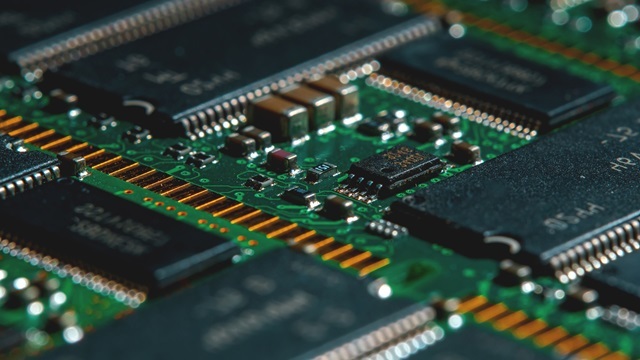Quantum Computing Meets Digital Engineering: The Next Leap in Innovation
Gerhard Friederici
24.06.2025
How Simulation and Classical Engineering Accelerate the Development of Quantum Computers
Quantum computers promise exponential computing power – but they only realize their potential through precise engineering. This article explains how digital engineering, through simulation, RF technology, and photonics, accelerates hardware maturity as well as what role hybrid systems will play in future product development.
Schalter sind standardisierte Serienprodukte. Das beschriebene Projekt wurde am Schaltwerk des Modells 506U durchgeführt | © JUNG
Why is Quantum Computing so Powerful?
Classic computers operate with two states (1 and 0), the so-called bits. These combinations of ones and zeros create texts, images, music, or even entire machines and buildings. In quantum computers, there are no bits, but rather qubits. These are not only able to take on the states 1 or 0, but also both simultaneously or, through superposition, any number of states in between. This allows a quantum computer to process many computational paths in parallel. The more qubits used, the more computing power is delivered.
Dr. Prith Banerjee, CTO at Ansys: “If I have p qubits, the speedup will be 2 to the power of p, which is exponential. Today’s IBM system Q has around 433 qubits or perhaps 1,000 qubits. They're announcing things with 2,000 qubits, 4,000 qubits by the year 2024. So, the speedup will be 2 to the power of 433, or 2 to the power of 4,000, which is a massive thing. Something that once took you 10,000 hours to run will work in seconds.” Full interview: CADFEM Blog
Quantum Computers in Product Development
Tech enthusiasts are thrilled by the projected computing power of quantum computers. Use cases seem limitless – from optimization tasks and materials research to cryptography. In the pharmaceutical and chemical industries, quantum computers could revolutionize molecule simulations to develop new medications more quickly. In the aerospace industry, quantum computers could perform the most complex fluid dynamics calculations. In IT, they could usher in a new era of cybersecurity (quantum cryptography). Quantum computing could also significantly accelerate machine learning.
Where Does Quantum Computing Stand Today?
Unfortunately, it's not quite that simple in reality. Before quantum computing can become a reliable component of digital engineering, the technology itself needs to be developed further. At least four approaches to realizing quantum computer technologies are currently being pursued:
- Superconducting circuits: Operate at temperatures near absolute zero (-273 °C).
- Ion traps: Individual atoms are held in electromagnetic fields and controlled with lasers to generate and manipulate qubits.
- Photonic systems: Use of photons to transmit and process quantum information.
- Neutral atoms: This method uses neutrally charged atoms that are captured and connected with light to perform quantum calculations.
A central challenge is the extreme sensitivity of quantum technologies. Even minimal environmental influences can cause errors, as qubit values are unstable. Temperature management of the “chandelier” – the structure holding the qubit chips – is critical, especially for superconducting qubits. Other factors include electromagnetic interference and vibrations. Solving these issues requires classical engineering.

3D-render of a quantum computer | © Adobe Stock
Accelerating Quantum Computer Development with Digital Engineering
We support companies – often highly innovative startups – in hardware development by applying our simulation expertise to the design and construction of quantum computers.
Quantum computer architecture includes specialized integrated circuits with qubits. Advanced technologies like RF (radio frequency) and photonics are used to input and output information. Once information leaves the quantum realm, it is processed with classical electronics and optimized using established RF component and PCB analysis tools.
Engineering Challenges and Automation
The main technical challenges are scaling the systems while controlling thermal stability and mechanical vibrations and avoiding electromagnetic interference. It's a bit like circus performers balancing spinning plates – everything must stay in harmony. Automation solutions, such as Python scripts, help automate recurring calculations, enabling development teams to work faster and more flexibly.
Let's Simulate – Knowledge Building Blocks for the Production of Quantum Computers
In this season, experts Alexander Shalaby and Ph.D. Steven Jones dive into the intersection of quantum computing and photonics. Discover how advancements in RF and photonics influence modern simulation techniques and how quantum effects come into play.

Ansys HFSS
Industry standard for determining the radiation and transmission behavior of high-frequency electromagnetic fields.

How Quantum Computing Can Boost Digital Engineering
Thanks to parallel processing, quantum computers will be able to calculate multiple scenarios simultaneously, significantly improving real-time simulations. They also enable extremely fast analysis of large datasets. This is a huge advantage, especially for complex optimization tasks that require immense computing power on traditional computer systems.
Key future application areas include:
- Simulation of quantum effects: Ideal for simulating quantum systems like molecular dynamics or nuclear physics.
- Optimization problems: Quantum algorithms like Grover’s can efficiently search large, unordered datasets – useful in engineering simulations.
- Machine learning and AI: Quantum computers can handle complex parameters, detect errors, and improve AI applications.
In the foreseeable future, quantum computers will not replace classical ones but will work alongside them as hybrid systems. In any case, the way products are developed, tested, and optimized will be revolutionized.
Peak Performance in Quantum Networks: Miraex, a Swiss Quantum Tech Startup
Simulations are already helping to develop the most powerful quantum computers possible. Miraex, a Swiss startup, develops connectors that link RF and photonics in the electromagnetic spectrum. These connectors are key to maximizing quantum computer performance. The foundation is a high-precision design that balances circuit and material losses with coupling strength – supported by multiphysics simulations using Ansys tools.
When RF and optical domains are connected – for example, linking quantum computers in a cluster via optical fibers – overall performance increases dramatically. The basis is nanoscale RF and optical circuits that guide light through structures where photons of different frequencies interact.
Simulation: Balancing Optical and Electrical Processes
Photon signals are converted between microwave and optical frequencies. Their operation requires precise design to balance circuit and material losses with coupling strength. The cross-domain result achieved by focusing on individual solvers in parallel threads leads to a drastic reduction in complexity and processing time.
These optimizations help identify the best design from the start, accelerate market access, and create outstanding conditions for innovation in industry and research through cutting-edge quantum technologies.




